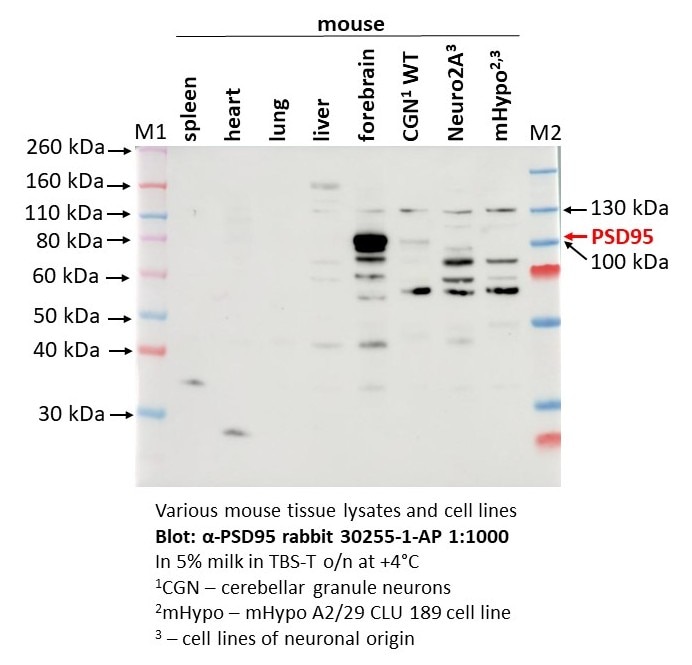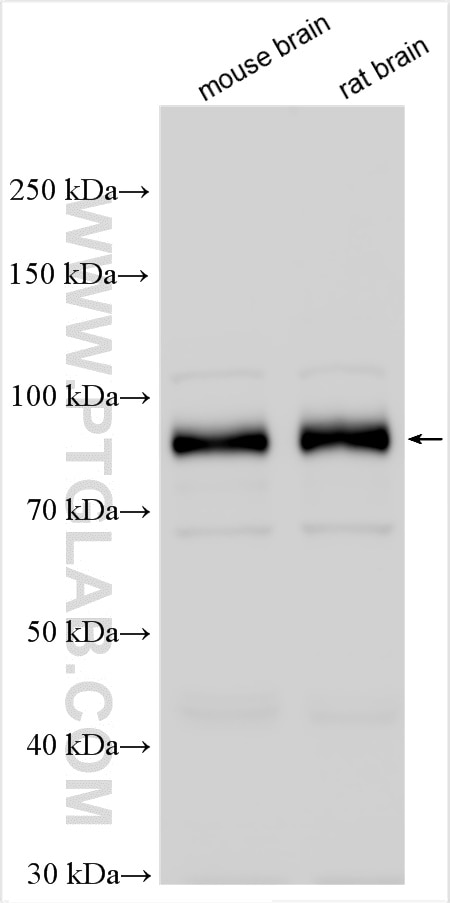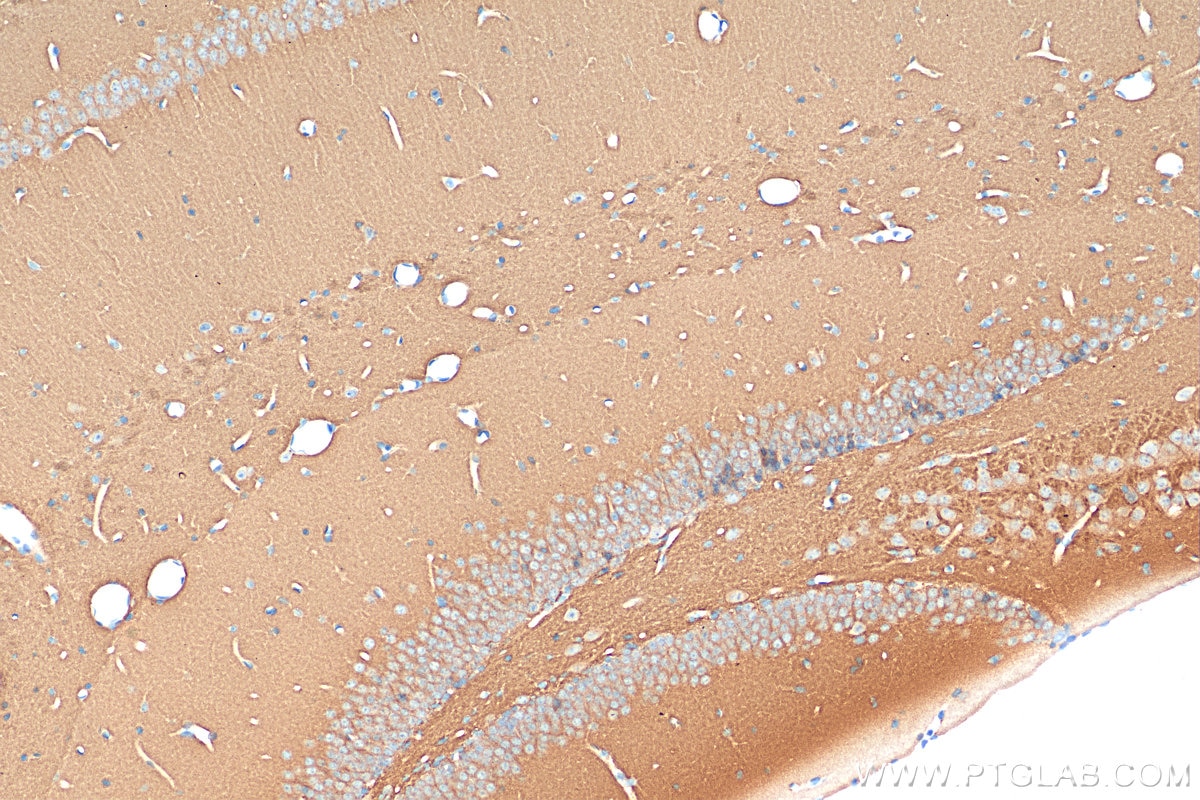Anticorps Polyclonal de lapin anti-PSD95
PSD95 Polyclonal Antibody for WB, IHC, ELISA
Hôte / Isotype
Lapin / IgG
Réactivité testée
Humain, rat, souris
Applications
WB, IHC, IF, ELISA
Conjugaison
Non conjugué
N° de cat : 30255-1-AP
Synonymes
Galerie de données de validation
Applications testées
| Résultats positifs en WB | tissu cérébral de souris, tissu cérébral de rat |
| Résultats positifs en IHC | tissu cérébral de souris, il est suggéré de démasquer l'antigène avec un tampon de TE buffer pH 9.0; (*) À défaut, 'le démasquage de l'antigène peut être 'effectué avec un tampon citrate pH 6,0. |
Dilution recommandée
| Application | Dilution |
|---|---|
| Western Blot (WB) | WB : 1:5000-1:50000 |
| Immunohistochimie (IHC) | IHC : 1:50-1:500 |
| It is recommended that this reagent should be titrated in each testing system to obtain optimal results. | |
| Sample-dependent, check data in validation data gallery | |
Applications publiées
| WB | See 12 publications below |
| IF | See 1 publications below |
Informations sur le produit
30255-1-AP cible PSD95 dans les applications de WB, IHC, IF, ELISA et montre une réactivité avec des échantillons Humain, rat, souris
| Réactivité | Humain, rat, souris |
| Réactivité citée | rat, Humain, souris |
| Hôte / Isotype | Lapin / IgG |
| Clonalité | Polyclonal |
| Type | Anticorps |
| Immunogène | PSD95 Protéine recombinante Ag33000 |
| Nom complet | discs, large homolog 4 (Drosophila) |
| Masse moléculaire calculée | 81 kDa |
| Poids moléculaire observé | 90-95 kDa |
| Numéro d’acquisition GenBank | NM_001365 |
| Symbole du gène | PSD95 |
| Identification du gène (NCBI) | 1742 |
| Conjugaison | Non conjugué |
| Forme | Liquide |
| Méthode de purification | Purification par affinité contre l'antigène |
| Tampon de stockage | PBS with 0.02% sodium azide and 50% glycerol |
| Conditions de stockage | Stocker à -20°C. Stable pendant un an après l'expédition. L'aliquotage n'est pas nécessaire pour le stockage à -20oC Les 20ul contiennent 0,1% de BSA. |
Informations générales
PSD-95 (postsynaptic density protein 95) also known as SAP-90 (synapse-associated protein 90) is a protein that in humans is encoded by the DLG4 (disks large homolog 4) gene. PSD-95 is a scaffolding protein of the MAGUK protein family, and engages in several vital protein-protein interactions in the brain with its PDZ domains. It has been suggested that PSD-95 is composed of two supramodules, one of which is the PDZ1-2 tandem domain. It plays an important role in synaptic plasticity and the stabilization of synaptic changes during long-term potentiation. Observed MW of PSD95 is 90-95 kDa due to phosphorylation (PMID: 20682303).
Protocole
| Product Specific Protocols | |
|---|---|
| WB protocol for PSD95 antibody 30255-1-AP | Download protocol |
| IHC protocol for PSD95 antibody 30255-1-AP | Download protocol |
| Standard Protocols | |
|---|---|
| Click here to view our Standard Protocols |
Publications
| Species | Application | Title |
|---|---|---|
J Ethnopharmacol Lancao decoction alleviates Alzheimer's disease: depending on activating CaMKII to protect neuronal refunction by reducing β-amyloid in the hippocampus | ||
FASEB J HDAC1/2/3-mediated downregulation of neurogranin is involved in cognitive impairment in offspring exposed to maternal subclinical hypothyroidism | ||
Actas Esp Psiquiatr Exercise-induced Activation of SIRT1/BDNF/mTORC1 Signaling Pathway: A Novel Mechanism to Reduce Neuroinflammation and Improve Post-stroke Depression | ||
Environ Pollut Bisphenol F exposure induces depression-like changes: Roles of the kynurenine metabolic pathway along the "liver-brain" axis | ||
Neurobiol Stress Effects of autotaxin and lysophosphatidic acid deficiencies on depression-like behaviors in mice exposed to chronic unpredictable mild stress | ||
Aging (Albany NY) Chronic stress induces Alzheimer's disease-like pathologies through DNA damage-Chk1-CIP2A signaling |
Avis
The reviews below have been submitted by verified Proteintech customers who received an incentive for providing their feedback.
FH Olga (Verified Customer) (10-03-2025) | You can surely dilute it more than 1:1000, as the signal was already saturated at 2.5 seconds of exposition. I find it better for mouse samples as it does not give non-specificity in non-brain tissues (comparing to 20665-1-AP PSD95 antibody) - all the mouse cells tested are of neuronal origin. The principal band size depends on protein marker used (see picture) - and can vary from 80 to 110 kDa.
 |
FH Alessandro (Verified Customer) (02-04-2025) | high specificity and sensitivity, providing reliable and reproducible results
|



